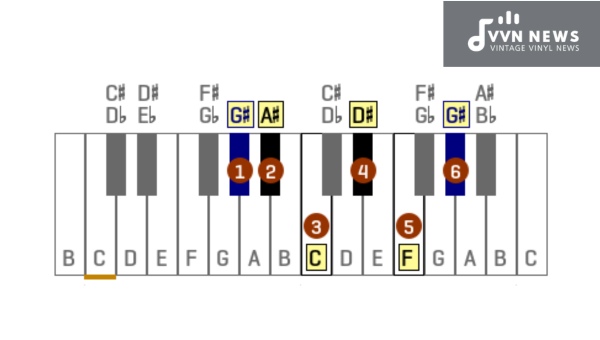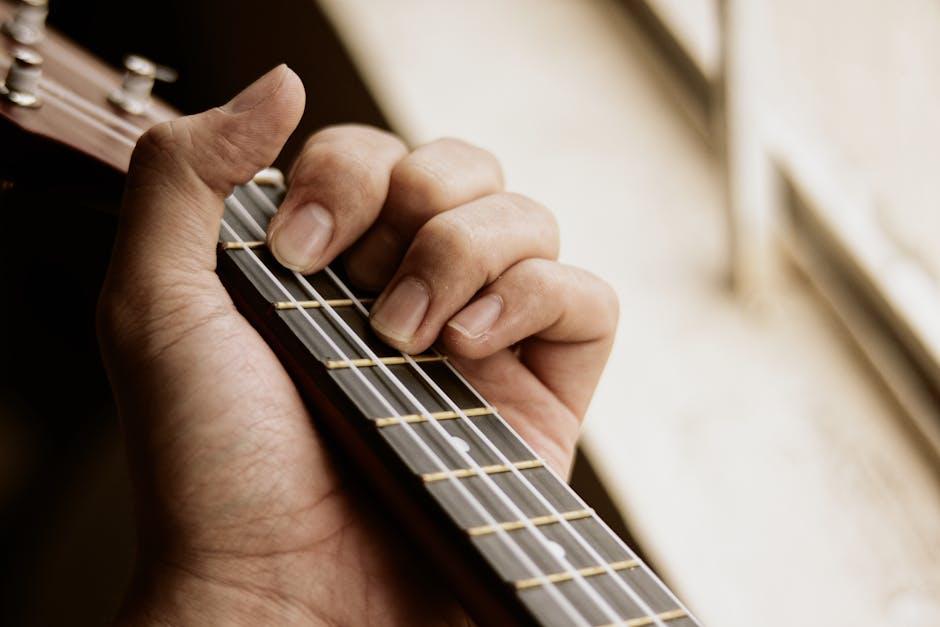So, you’ve decided to pick up the guitar and become the next rockstar sensation. But before you start dreaming of headlining sold-out arenas, let’s start with the basics: scales. Yes, those elusive patterns of notes that can sometimes make your fingers feel like they’re doing a chaotic dance on the fretboard. But fear not, dear beginner, for we are here to guide you through the mystical world of guitar scales with a touch of humor and a whole lot of groovy tunes. Let’s embark on this musical journey together, one scale at a time!
Contents
- 1 Understanding the Fundamentals of Guitar Scales
- 2 The Major Scale: Your First Step into Guitar Mastery
- 3 Exploring the Minor Scale: A Doorway to Emotional Expression
- 4 The Pentatonic Scale: Simplifying Your Soloing Skills
- 5 Diving Deeper with the Blues Scale
- 6 Chromatic Scales: Expanding Your Fretboard Knowledge
- 7 Navigating the Modes: Broadening Your Musical Palette
- 8 FAQs
- 9 Rock on and Keep Practicing!
Understanding the Fundamentals of Guitar Scales
Let’s dive straight into the world of guitar scales, shall we? It’s like a secret code that unlocks the mysteries of music - or something like that. Don’t worry, I won’t get too technical on you. We’re here to have some fun!
First things first, a guitar scale is basically a group of notes played in a specific sequence. Think of them as the building blocks of melodies and solos. Now, let’s talk about the two main types of scales:
- Major Scales - The happy, upbeat ones that make you want to dance around the room like a maniac.
- Minor Scales – The moody, introspective ones that make you want to contemplate the meaning of life.
Now, here’s where it gets a little tricky. Each scale is made up of different intervals, which are the spaces between the notes. It’s like a musical puzzle that you have to put together, but instead of a picture of a kitten, you get a killer guitar solo at the end. Win-win, am I right?

The Major Scale: Your First Step into Guitar Mastery
So you’ve picked up a guitar and you’re ready to embark on the exciting journey of mastering this six-stringed beast. But where do you start? Fear not, my friend, for the major scale is here to guide you on your path to guitar greatness!
Think of the major scale as the building blocks of music theory - it’s the foundation upon which all other scales and chords are built. Once you understand the major scale, you’ll have a solid grasp of the musical landscape and be able to navigate it with ease.
With its seven unique notes, the major scale is like a magical formula that unlocks the secrets of music. By learning the pattern of intervals between these notes, you’ll be able to play any major scale in any key with confidence and flair.
So grab your guitar, dust off those strings, and dive headfirst into the wonderful world of the major scale. It may seem daunting at first, but with practice and determination, you’ll soon be shredding like a rock god in no time. Remember, every guitar master started with the major scale – it’s your key to unlocking a world of musical possibilities!
Exploring the Minor Scale: A Doorway to Emotional Expression
Have you ever heard a song and felt an intense rush of emotions? Maybe it made you cry, or dance uncontrollably, or even burst into laughter for no reason. Well, my friend, chances are that song was written using the minor scale. It’s like the secret code to unlocking a floodgate of feelings in music.
Think of the minor scale as the emotional teenager of the musical world. It’s moody, brooding, and just a little bit rebellious. When you hear those haunting notes, you know you’re in for a rollercoaster ride of emotions. It’s like listening to your favorite breakup song on repeat while eating ice cream straight out of the tub – a cathartic experience, to say the least.
Exploring the minor scale is like venturing into the depths of your own soul. It’s where you confront your inner demons, embrace your vulnerabilities, and maybe even discover a hidden strength you never knew you had. So grab your tissues, your dancing shoes, or whatever you need to express yourself, and let the minor scale be your guide on this emotional journey through music.
- Feel the melancholy of the minor scale
- Dance through the darkness with its haunting melodies
- Explore the bittersweet beauty of emotional expression

The Pentatonic Scale: Simplifying Your Soloing Skills
Are you tired of feeling lost when it comes to soloing on the guitar? Well, fear not, because we have the solution for you – the pentatonic scale! This magical five-note scale has been the secret weapon of guitarists for centuries, and it’s about time you hopped on the bandwagon.
With the pentatonic scale, you can say goodbye to the days of aimlessly noodling around on your guitar, hoping that something will sound good. Instead, you can confidently navigate the fretboard like a pro, knowing exactly which notes will fit perfectly over any chord progression.
So, how does it work? It’s simple - just learn the five shapes of the pentatonic scale, practice them until your fingers bleed (figuratively, of course), and then unleash your newfound soloing skills on the world. Trust us, you’ll never look back.
Don’t believe us? Well, just ask any guitar god worth their salt – they’ll tell you that the pentatonic scale is the key to unlocking your full potential as a soloist. Plus, it’s a great party trick to impress your friends with. Who doesn’t love a good pentatonic solo?

Diving Deeper with the Blues Scale
So you think you know the blues scale, huh? Well, buckle up, because we’re about to take a deep dive into the world of this classic musical scale. Get ready to have your mind blown and your blues licks revolutionized!
First off, let’s talk about the notes that make up the blues scale. We’ve got the trusty ol’ root note, followed by the flattened third, perfect fourth, flattened fifth, natural fifth, and flattened seventh. Sound confusing? Don’t worry, once you start playing around with these notes, you’ll start to hear that signature bluesy sound come to life.
Now, let’s talk about how to use the blues scale in your playing. It’s not just about mindlessly running up and down the scale (although that can be fun too). Try adding some bends, slides, and vibrato to really bring out that soulful feel. And don’t forget to experiment with different rhythms and phrasing to add some spice to your blues licks.
And finally, don’t be afraid to break the rules with the blues scale. Mix in some other scales, throw in a chromatic passing tone, or even add in some unexpected notes for a truly unique sound. Remember, the blues is all about expressing yourself and letting your emotions flow through your playing. So go ahead, dive deeper with the blues scale and let your creativity run wild!
Chromatic Scales: Expanding Your Fretboard Knowledge
So you think you know everything about those pesky chromatic scales, huh? Think again! There’s always more to learn when it comes to expanding your fretboard knowledge. Get ready to embark on a journey through the magical world of chromatic scales, where the possibilities are endless and the frets are plentiful.
**Unleash the Power of Chromatic Madness:** By exploring chromatic scales, you’ll start to see patterns emerge that you never noticed before. Suddenly, those seemingly random notes on the fretboard will start to make sense, and you’ll be able to navigate your way around like a pro. Say goodbye to feeling lost and hello to feeling like a fretboard master!
**Discover New Sounds:** One of the best things about working with chromatic scales is the ability to create unique and interesting sounds. By adding chromatic notes into your playing, you’ll be able to spice things up and really impress your audience. Who knew that a simple chromatic scale could be so versatile?
**Challenge Yourself:** Ready to take your fretboard knowledge to the next level? Challenge yourself to learn chromatic scales in different positions and keys. Push yourself to try new techniques and experiment with different phrasing. The more you practice, the more confident you’ll become in your abilities. Who knows, you might even discover your own signature sound along the way!
So you’ve mastered the art of playing in major and minor keys, but you’re feeling stuck in a musical rut. Fear not, dear musician, for there are plenty of other modes out there just waiting for you to explore! By broadening your musical palette and delving into different modes, you can add new colors and flavors to your compositions. Here are a few tips to help you navigate the vast world of musical modes:
First off, let’s break down the seven modes of the major scale: Ionian, Dorian, Phrygian, Lydian, Mixolydian, Aeolian, and Locrian. Each mode has its own unique sound and character, so don’t be afraid to experiment and see which ones resonate with you.
One way to get comfortable with playing in different modes is to practice improvising over backing tracks in each mode. This will help you get a feel for the distinct characteristics of each mode and how they can be used to create different moods and emotions in your music.
Remember, the key to mastering the modes is practice, practice, practice! Don’t be afraid to make mistakes and embrace the quirks and nuances of each mode. Before you know it, you’ll be navigating the modes like a seasoned pro, ready to wow audiences with your newfound musical versatility. So go forth, brave explorer, and may the modes be ever in your favor!
FAQs
What are guitar scales and why are they important?
Guitar scales are like the alphabet of music. Just as you need to know your ABCs to write words, understanding scales is crucial for playing music. They help you create melodies, improvise, and jam with others.
How do I memorize all the different scales?
Think of scales as your new best friends. Spend quality time with each scale, get to know their quirks and personalities. Practice regularly and soon enough, you’ll be able to recall them like old pals.
Can I just stick to one scale and be good at playing guitar?
Sure, you can stick to one scale, but that’s like eating the same flavor of ice cream every day. It might get boring after a while. Experiment with different scales to add flavor to your playing and keep things interesting.
Do I have to learn every single scale out there?
Unless you’re aiming to be a guitar scale encyclopedia, you don’t need to learn every single scale. Focus on the basics first, like the major and minor scales, and branch out from there based on your musical interests.
How can scales help me with my guitar solos?
Think of scales as your secret weapon for guitar solos. They give you a roadmap to follow when improvising, helping you hit the right notes and sound like a rockstar. Plus, knowing scales can boost your confidence on stage.
Any tips for mastering guitar scales faster?
Repetition is key, my friend. Practice, practice, and then practice some more. Break down the scales into smaller chunks, play them slowly at first, and gradually increase your speed. And don’t forget to have fun along the way!
Rock on and Keep Practicing!
So there you have it, beginner guitarists! You’ve just scratched the surface of the wonderful world of guitar scales. Remember, practice makes perfect, so keep strumming those strings and mastering those basic scales. Before you know it, you’ll be shredding like a rockstar and impressing all your friends. Rock on!



